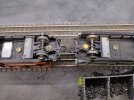76043
Western Thunderer
Hi Rob,
I found for Dublingham, three things are necessary for good exhibition running, spotless track, feedback and well maintained locos. All obvious, but I wonder what DC system you were using, was it feedback? As I understand it all Zimo DCC chips have feedback built in, so does this explain why you are getting better running under DCC if your DC controller was not feedback?
I also fitted track sweepers under the two brake vans to clear debris during the day at a show. They are obviously not to everyone's taste, but by the look of mine are doing a job.

Tony
I found for Dublingham, three things are necessary for good exhibition running, spotless track, feedback and well maintained locos. All obvious, but I wonder what DC system you were using, was it feedback? As I understand it all Zimo DCC chips have feedback built in, so does this explain why you are getting better running under DCC if your DC controller was not feedback?
I also fitted track sweepers under the two brake vans to clear debris during the day at a show. They are obviously not to everyone's taste, but by the look of mine are doing a job.

Tony
Last edited:








 - is to use RocoLine (with roadbed) or Trix C track where the point motor is contained within the ready ballasted road bed.
- is to use RocoLine (with roadbed) or Trix C track where the point motor is contained within the ready ballasted road bed.